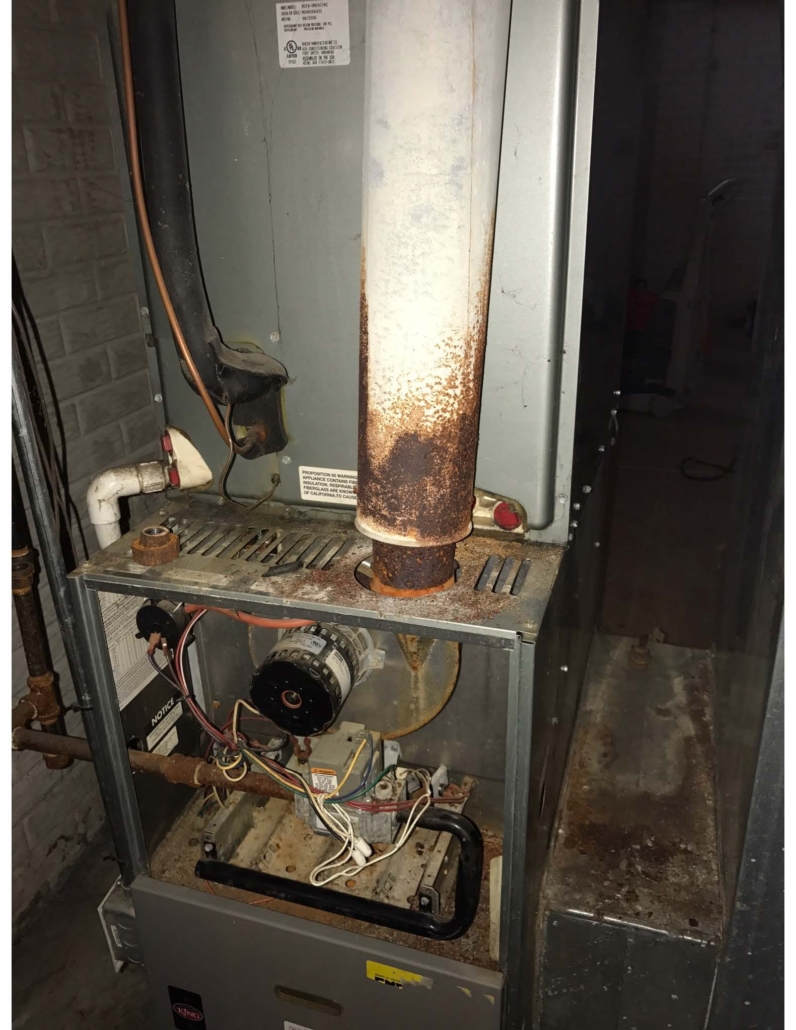FAQ: What is the most Common Mistake which causes carbon monoxide poisoning that Management Companies make?
Short Answer: Failing to do preventative maintenance of fuel burning appliances on an annual basis.

What is the Most Common Mistake which Causes Carbon Monoxide? Failure of the management company to do annual preventative maintenance, which in this case, would have flagged the corrosion on the exhaust pipe. A simple combustion analysis would have then discovered the severely high levels of CO in the exhaust.
From our series of video’s on YouTube about frequently asked carbon monoxide questions between Attorneys Gordon Johnson and Griffith Winthrop:
Gordon Johnson: All right, I’m going to ask you a question, and then I’m going to share my screen as you answer it. What did the management company who was maintaining the furnace in that house do wrong? And I’m going to share my screen.
Griff Winthrop: They did not have regular periodic preventative maintenance on this furnace. This furnace was ten years old when this picture was taken.
Gordon Johnson: So what are the telltale signs of carbon monoxide in this photograph?
Griff Winthrop: Well let’s start. Let’s go from bottom to top. You can see in the bottom there in the burner pan. That is a lot of corrosion.
Gordon Johnson: And about down here at the bottom.
Griff Winthrop: Yes, sir. Underneath there and under that burner pan you can see what shouldn’t be there. You got rust. And if you look at that little point, which is next to the inducer motor, you can see a telltale sign there, which is looks like you’ve got drippage, you’ve got some moisture that is dripping down that should not be there either. And the reason that’s a problem is because when you have incomplete combustion and you have the products of combustion are riddled with carbon monoxide the water vapor condenses and it’s very acidic, and it causes rust, which is a sign that you have a moisture problem. And if you have a moisture problem, you probably have high amounts of carbon monoxide in the exhaust flue gas.
FAQ What types of condensation and corrosion are telltale signs of imminent carbon monoxide poisoning?
Gordon Johnson: How do we know this condensation is significant. If I were to So I go int0 my utility room here, down the hall, there’ll be a water on the floor. Likely, water stains on the floor near the drain. Is that the same concern that we see here?
Griff Winthrop: No. That’s condensate from the air conditioner. And it’s doing what it’s supposed to do. It’s condensing the air and it’s which creates moisture. And moisture has to be flushed, has to be whisked away. And that’s what your system does.
Gordon Johnson: Now, what’s different about the rust in this picture? Would never see rust from an air conditioner on the exhaust pipe.
Griff Winthrop: No, of course not. But what has happened here is we have, you can see there’s a slight tilt to that pipe. And this has always been my theory of the case is there was a breach and that is the exhaust flue pipe. That is where the products of combustion are supposed to be exhausted out of the out of this particular house.
Essentially the chimney for this furnace.
FAQ: What is an induced draft furnace?
Griff Winthrop: Induced draft means this is a mechanically driven process. It sucks air combustion air in from that basement room that it’s in. And then it its second function is to push that the products of combustion after they’ve been burned out of that chimney. So it creates a suction on the front end and it pushes out the back end. And then the chimney is supposed to assist as well through gravity and heat rising principles to assist that fan to get it out. And that is what you can see happening here and here.
And you can see it’s one wonderful thing about corrosion is it does leave a mark, right. It leaves a fingerprint if you will. And in this particular boiler or excuse me, furnace. The rust that we’re seeing is evidence that this moisture was escaping the high, high amounts of very corrosive moisture is escaping that furnace combustion process from, from that chimney and is rusting that chimney. The other thing that was happening we found this out was this was an over fired furnace. It had this.
Gordon Johnson: This furnace looks like it’s 20 or 30 years old.
Griff Winthrop: It does look like it’s 20 or 30 years old. And that’s because it was never maintained. And this would have been caught. And it was admitted. You and I took the depositions of all of the technicians, and they all admitted when they saw these pictures that this should have been caught, if there had been a regular maintenance program as required by all the industry standards, this would have been caught early on. And this moisture problem would have been detected. They would have realized what was happening. This moisture problem got so bad that it was the root of the problem. It it clogged the fuel valve.

Leave a Reply
Want to join the discussion?Feel free to contribute!